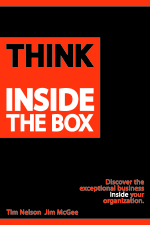Tim and I are speaking next week at the monthly North Shore Interest Group of the Harvard Business School Club of Chicago. Here are the details:
HBS Club of Chicago: “NSIG: North Shore Special Interest Group: March Meeting Announcement
NSIG Breakfast Thursday, March 13, 2014 7:30-9:00 am Max & Bennys, Northbrook

Taking 80/20 Thinking into Another Dimension: Tim Nelson and Jim McGee (HBS 1980)
Vilfredo Pareto formulated the 80/20 principle in 1906. Quality consultant Joe Juran brought it to management’s attention in the 1940s. Business schools teach it. Most managers pay it lip service or ignore it for the latest ‘bright, shiny, object.’ For our March breakfast meeting, hear authors Tim Nelson and Jim McGee (HBS 1980) discuss their new book Think Inside the Box: Discover the Exceptional Business Inside Your Organization (WCG Press, 2013). They’ll make the case that there’s plenty of mileage left in the 80/20 principle and that there is even more power in expanding 80/20 to two dimensions.
Plan for a highly interactive discussion with Nelson and McGee on:
- Why 80/20 thinking matters more than ever in a complex world
- The power of 80/20 squared; combining 80/20 analysis of products and customers
- Why simple analysis bridges organizational silos
- Why organizations should learn to do this analysis for themselves

Tim Nelson founded Midwest Industrial Packaging in 1987 and sold it to Illinois Tool Works in 2000. From 2000 to 2008, he served as Vice President and General Manager for ITW in several divisions. Tim divides his time between developing and applying the ideas behind Think Inside the Box with multiple businesses and founding and growing Encore Packaging of Lake Bluff. Tim has an undergraduate degree in Finance from San Diego State University and an MBA in Operations and Accounting from the University of Chicago.
Jim McGee was a founder of Diamond Management & Technology Consultants (now part of Price Waterhouse Coopers) helping it grow from 25 employees in 1994 to over 1,000 consultants and $260 million in revenue in 2000. Jim divides his time between writing, teaching, and consulting. Jim has an undergraduate degree in Statistics from Princeton and an MBA and Doctorate from Harvard Business School.
EVENT DETAILS: DATE: Thursday, March 13, 2014 TIME: 7:30-9:00 am LOCATION: Max & Benny’s (Brookside Shopping Center), 461 Waukegan Road, Northbrook COST: Please prepay now through the club website HBSCC members and their guests (with prepaid reservation): $20.00 HBSCC members (without prepaid reservation): $30.00 HBSCC Patron and Patron Plus Guest Pass members: FREE! Non-members of HBSCC (with prepaid reservation): $30.00
Reservation deadline: Wednesday, March 12, 2014




